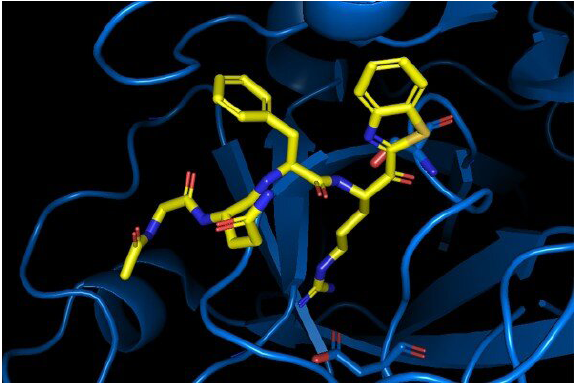博文
抗病毒化合物阻止SARS-CoV-2进入细胞
 精选
精选
||
抗病毒化合物阻止SARS-CoV-2进入细胞
诸平

据美国圣路易斯华盛顿大学(Washington University in St. Louis)2021年10月12日提供的消息,该校医学院生物化学与分子生物物理学系、分子微生物学系的研究人员与圣路易斯的ProteXase治疗公司(ProteXase Therapeutics, Inc.)、哈佛医学院病毒学项目组(Program in Virology, Harvard Medical School)、加州大学旧金山分校药物化学系(Department of Pharmaceutical Chemistry, University of California, San Francisco)、加州大学圣地亚哥分校斯卡格斯药学院(Skaggs School of Pharmacy and Pharmaceutical Sciences, University of California San Diego)、辛辛那提大学医学院小儿科学系(Department of Pediatrics, University of Cincinnati College of Medicine)、辛辛那提儿童医院医疗中心过敏和免疫科(Division of Allergy and Immunology, Cincinnati Children’s Hospital Medical Center);德国莱布尼茨灵长类动物研究所灵长类动物中心感染生物学组(Infection Biology Unit, German Primate Center, Leibniz Institute for Primate Research)、德国哥廷根乔治-奥古斯特大学生物与心理学学院(Faculty of Biology and Psychology, Georg-August University Göttingen)的研究人员合作开发了一种化合物,这种化合物可以干扰许多病毒的一个关键特征,使病毒能够入侵人类细胞。研究人员称,这种名为MM3122的化合物在细胞和小鼠中进行了研究,如果在感染过程的早期服用,有望成为预防感染或减轻COVID-19严重程度的新方法(Antiviral compound blocks SARS-CoV-2 from entering cells)。 相关研究结果于2021年10月11日已经在《美国国家科学院院刊》(Proceedings of the National Academy of Sciences)网站发表——Matthew Mahoney, Vishnu C. Damalanka, Michael A. Tartell, Dong hee Chung, André Luiz Lourenço, Dustin Pwee, Anne E. Mayer Bridwell, Markus Hoffmann, Jorine Voss, Partha Karmakar, Nurit P. Azouz, Andrea M. Klingler, Paul W. Rothlauf, Cassandra E. Thompson, Melody Lee, Lidija Klampfer, Christina L. Stallings, Marc E. Rothenberg, Stefan Pöhlmann, Sean P. J. Whelan, Anthony J. O’Donoghue, Charles S. Craik, James W. Janetka. A novel class of TMPRSS2 inhibitors potently block SARS-CoV-2 and MERS-CoV viral entry and protect human epithelial lung cells. Proceedings of the National Academy of Sciences, October 26, 2021, 118(43): e2108728118. DOI:10.1073/pnas.2108728118. Published online Oct. 11, 2021. https://doi.org/10.1073/pnas.2108728118
有趣的是,这种化合物针对一种名为跨膜丝氨酸蛋白酶2 (transmembrane serine protease 2简称TMPRSS2)的关键人类蛋白,冠状病毒利用这种蛋白进入并感染人类细胞。
上述论文的通讯作者、也是一名生物化学和分子生物物理学教授詹姆斯·珍妮特卡(James W. Janetka)博士说:“目前已有针对SARS-CoV-2的许多疫苗,但我们仍然需要有效的抗病毒药物,以帮助遏制这场新冠病毒大流行的严重性。我们正在开发的此化合物可以阻止病毒进入细胞。我们正在研究治疗窗口,在这个窗口内,将这种分子可以用于小鼠,发现可以保护它们免受新冠病毒的侵袭。我们的最终目标是将这些分子发展成一种可口服的抑制剂,从而成为我们COVID-19抑制剂医疗设备的有效组成部分。”
这种新型药物化合物能有效地阻断TMPRSS2和另一种相关蛋白——matripase,它们存在于肺和其他细胞的表面。许多病毒,包括导致COVID-19的SARS-CoV-2,以及其他冠状病毒和流感,都依赖这些蛋白质感染细胞并在整个肺部传播。病毒附着在气道上皮细胞上后,人类蛋白TMPRSS2切断病毒的刺突蛋白,激活刺突蛋白介导病毒和细胞膜的融合,启动感染过程。MM3122阻断了人类蛋白TMPRSS2的酶活性。当这种酶被阻断时,它会扰乱刺突蛋白的激活并抑制膜融合。
詹姆斯·珍妮特卡说:“SARS-CoV-2病毒劫持了我们自己的肺细胞的机制,激活它的刺突蛋白,这使它能够结合和入侵肺细胞。在阻断TMPRSS2的过程中,如果理论上可以作为一种预防措施,该药物首先可以防止病毒进入体内其他细胞或入侵肺部细胞。我们现在正在小鼠模型中测试这种化合物,并结合针对病毒其他关键部位的其他治疗方法,努力开发一种有效的广谱抗病毒疗法,对COVID-19和其他病毒感染有用。”
MM3122研究了在实验室中生长的感染了SARS-CoV-2的细胞,它比瑞德西韦(remdesivir)更能保护细胞免受此病毒损伤。瑞德西韦已被美国食品和药物管理局(Food and Drug Administration)批准用于治疗COVID-19患者。在老鼠身上进行的一项急性安全测试表明,大剂量的此化合物在连续服用7天内不会引起任何明显的问题。研究人员还证明,该化合物对原始的严重急性呼吸综合征冠状病毒(SARS-CoV)和中东呼吸综合征冠状病毒(MERS-CoV)同样有效。
Marvin A. Brennecke杰出教授、圣路易斯华盛顿大学分子微生物学系主任,也是上述论文的合作者肖恩·蕙兰(Sean Whelan)博士说:“一旦病毒进入细胞内,大多数病毒感染抑制剂通过阻断复制步骤发挥作用。”詹姆斯·珍妮特卡博士已经确定并改进了一种分子,它可以阻止病毒进入细胞。由于MM3122的靶蛋白是一种宿主蛋白,这也可能对对抑制剂有抗性的病毒的出现构成更大的障碍。”
詹姆斯·珍妮特卡补充说:“这种化合物不仅用于COVID-19。它可能会抑制其他冠状病毒甚至流感病毒的进入。这些病毒都依赖相同的人类蛋白质来入侵肺细胞。因此,通过阻断人类蛋白质,我们可以阻止任何试图劫持这些蛋白质的病毒进入细胞。”
詹姆斯·珍妮特卡和他的同事目前正在与美国国立卫生研究院(NIH)的研究人员合作,在动物模型中测试MM3122治疗和预防COVID-19的有效性。在动物实验中,这种药物是注射给药,但詹姆斯·珍妮特卡说,他们正在努力开发一种可以口服的改良化合物。他还对开发一种将药物更直接地送到鼻腔通道和肺部的鼻内途径感兴趣。
詹姆斯·珍妮特卡与华盛顿大学技术管理办公室(Washington University's Office of Technology Management)合作,共同创立了一家名为ProteXase Therapeutics的生物技术初创公司,该公司已得到了这项技术的许可,以帮助开发一种新的药物治疗冠状病毒,包括SARS-CoV-2、最初的SARS-CoV和MERS-CoV。
上述介绍,仅供参考。欲了解更多信息,敬请注意浏览原文或者相关报道。
Researchers demonstrate vaccination approach in mice that could prevent future coronavirus outbreaks
MM3122 represents an advanced lead candidate for clinical development as a novel antiviral drug for COVID-19. In addition to being novel drugs, these selective TMRSS2 inhibitors can be used as valuable chemical probes to help elucidate mechanisms of viral pathogenesis. Since TMPRSS2 plays a key role as a viral protein processing protease in the pathogenesis of other coronaviruses (SARS-CoV, MERS-CoV) as well as influenza viruses, MM3122 and this class of TMPRSS2 inhibitors hold much promise as new drugs to not only treat SARS-CoV-2 infections but also potentially represent broad-spectrum antivirals.
The host cell serine protease TMPRSS2 is an attractive therapeutic target for COVID-19 drug discovery. This protease activates the Spike protein of severe acute respiratory syndrome coronavirus 2 (SARS-CoV-2) and of other coronaviruses and is essential for viral spread in the lung. Utilizing rational structure-based drug design (SBDD) coupled to substrate specificity screening of TMPRSS2, we have discovered covalent small-molecule ketobenzothiazole (kbt) TMPRSS2 inhibitors which are structurally distinct from and have significantly improved activity over the existing known inhibitors Camostat and Nafamostat. Lead compound MM3122 (4) has an IC50 (half-maximal inhibitory concentration) of 340 pM against recombinant full-length TMPRSS2 protein, an EC50 (half-maximal effective concentration) of 430 pM in blocking host cell entry into Calu-3 human lung epithelial cells of a newly developed VSV-SARS-CoV-2 chimeric virus, and an EC50 of 74 nM in inhibiting cytopathic effects induced by SARS-CoV-2 virus in Calu-3 cells. Further, MM3122 blocks Middle East respiratory syndrome coronavirus (MERS-CoV) cell entry with an EC50 of 870 pM. MM3122 has excellent metabolic stability, safety, and pharmacokinetics in mice, with a half-life of 8.6 h in plasma and 7.5 h in lung tissue, making it suitable for in vivo efficacy evaluation and a promising drug candidate for COVID-19 treatment.
https://blog.sciencenet.cn/blog-212210-1307864.html
上一篇:化学家发现了快速作用的杀虫剂吡虫啉晶形
下一篇:表面化学揭示了腐蚀的秘密